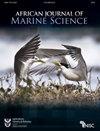对占据海岸的大型动物群落在全粒径范围内的比较表明,卵石海滩是一种独特的海岸栖息地类型
IF 1.4
4区 生物学
Q3 MARINE & FRESHWATER BIOLOGY
引用次数: 2
摘要
潮间带研究主要集中在非常细到粗糙的沙滩(粒度256毫米)和岩石海岸,主要是由食腹足类动物进行的。粒径4-<64毫米的海岸被一个独特但以前未被识别的大型动物群落所占据,其特征是贫穷的动物群以小型、可移动、主要呼吸空气的节肢动物类群为主。本文章由计算机程序翻译,如有差异,请以英文原文为准。
Comparisons of macrofaunal communities occupying shores across the full particle-size spectrum reveals pebble beaches to be a distinct coastal habitat type
Intertidal research has focused primarily on very fine to coarse sandy beaches (grain size <1 mm) and on rocky shores, while shores with grain sizes of 1-256+ mm have rarely been studied. Within South Africa, few published accounts describe the biota of very coarse sand (1-<2 mm), granule (2-<4 mm), pebble (4-<64 mm) or cobble (64-<256 mm) shores, and only one reports on boulder (256+ mm) shores. The objective here was to determine how many distinct habitat types occur across the full spectrum of particle sizes within this region, and what taxa characterise the biota of each habitat type. Biota from 14 shores of grain sizes 1-256 mm within the Western Cape Province (southeastern Atlantic Ocean) were sampled and compared with similar published data from 32 other regional sites with either finer or coarser grain size. Three main groupings emerged from a similarity analysis: sandy shores (of particle size <1 mm); pebble (4-<64 mm) shores; and boulder (256+ mm) plus rocky shores, with cobbles serving as a transition between those two. Sandy shores were characterised by various burrowing taxa, and boulder (>256 mm) and rocky shores mostly by grazing gastropods. Shores of 4-<64 mm particle grain size were colonised by a distinctive but previously unrecognised macrofaunal community characterised by an impoverished fauna dominated by small, mobile, mostly air-breathing arthropod taxa.
求助全文
通过发布文献求助,成功后即可免费获取论文全文。
去求助
来源期刊

African Journal of Marine Science
生物-海洋与淡水生物学
CiteScore
2.60
自引率
16.70%
发文量
17
审稿时长
6-12 weeks
期刊介绍:
The African (formerly South African) Journal of Marine Science provides an international forum for the publication of original scientific contributions or critical reviews, involving oceanic, shelf or estuarine waters, inclusive of oceanography, studies of organisms and their habitats, and aquaculture. Papers on the conservation and management of living resources, relevant social science and governance, or new techniques, are all welcomed, as are those that integrate different disciplines. Priority will be given to rigorous, question-driven research, rather than descriptive research. Contributions from African waters, including the Southern Ocean, are particularly encouraged, although not to the exclusion of those from elsewhere that have relevance to the African context. Submissions may take the form of a paper or a short communication. The journal aims to achieve a balanced representation of subject areas but also publishes proceedings of symposia in dedicated issues, as well as guest-edited suites on thematic topics in regular issues.
 求助内容:
求助内容: 应助结果提醒方式:
应助结果提醒方式:


